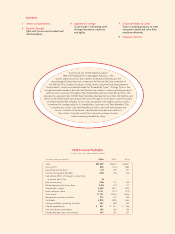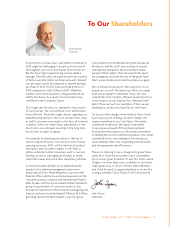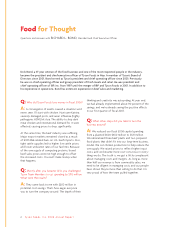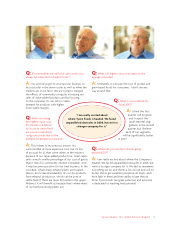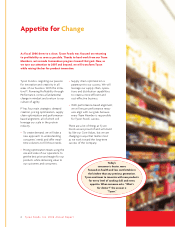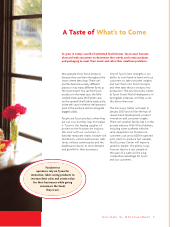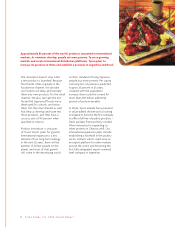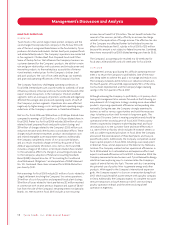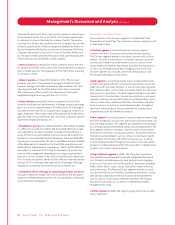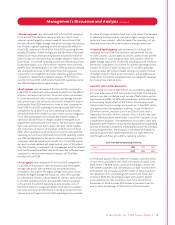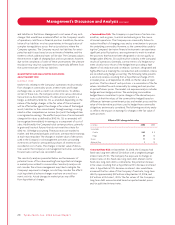Tyson Foods 2006 Annual Report Download - page 12
Download and view the complete annual report
Please find page 12 of the 2006 Tyson Foods annual report below. You can navigate through the pages in the report by either clicking on the pages listed below, or by using the keyword search tool below to find specific information within the annual report.
10 Ty s on Foods, Inc. 2006 Annual Report
RESULTS OF OPERATIONS
OVERVIEW
Tyson Foods is the world’s largest meat protein company and the
second largest food production company in theFortune 500 with
one of the most recognized brand names in the food industry. Tyson
produces, distributes and markets chicken, beef, pork, prepared foods
and related allied products. The Company’s operations are conducted
in five segments: Chicken, Beef, Pork, Prepared Foods and Other.
Some of the key factors that influence the Company’s business are
customer demand for the Company’s products, the ability to main-
tain and grow relationships with customers and introduce new and
innovative products to the marketplace, accessibility of interna-
tional markets, market prices for the Company’s chicken, beef
and pork products, the cost of live cattle and hogs, raw materials
and grain and operating efficiencies of the Company’s facilities.
The Company faced very challenging operating conditions in
fiscal 2006. Demand pressures caused mainly by outbreaks of avian
influenza, primarily in Europe and Asia, Hurricane Katrina and other
export market disruptions in the Company’s Chicken and Beef
segments, led to an oversupply of proteins worldwide and negatively
affected the average sales prices and operating results of each of
the Company’s protein segments. Operations also were affected
negatively by higher energy costs, and significant operating margin
reductions at the Company’s operations in Canada and Mexico.
Net loss for fiscal 2006 was $196 million, or $0.58 per diluted share,
compared to earnings of $372 million, or $1.04 per diluted share, in
fiscal 2005. Pretax loss for fiscal 2006 includes $63 million of costs
related to beef, prepared foods and poultry plant closings and
$19 million of charges related to the Company’s $200 million cost
reduction initiative and other business consolidation efforts. These
charges include severance expenses, product rationalization costs
and related intangible asset impairment expenses. Additionally,
the Company completed a review of its tax account balances,
and as a result, recorded a charge in the fourth quarter of fiscal
2006 of approximately $15 million. Also, net loss for fiscal 2006
includes a charge of $5 million, or $0.02 per diluted share, related
to the cumulative effect of a change in accounting principle due
to the Company’s adoption of Financial Accounting Standards
Board (FASB) Interpretation No. 47, “Accounting for Conditional
Asset Retirement Obligations,” an interpretation of FASB Statement
No. 143. Combined, these items increased fiscal 2006 diluted loss
per share by $0.21.
Pretax earnings for fiscal 2005 include $33 million of costs related to
a legal settlement involving the Company’s live swine operations,
$14 million of costs for poultry and prepared foods plant closings,
$8 million of losses related to Hurricane Katrina, $12 million received
in connection with vitamin antitrust litigation and a gain of $8 mil-
lion from the sale of the Company’s remaining interest in Specialty
Brands, Inc. Net income in fiscal 2005 includes a non-recurring
income tax net benefit of $15 million. The net benefit includes the
reversal of tax reserves, partially offset by an income tax charge
related to the repatriation of foreign income. The effective tax rate
of the Company was affected further by the federal income tax
effect of the Medicare Part D subsidy in fiscal 2005 of $55 million
because this amount is not subject to federal income tax. Combined,
these items increased fiscal 2005 diluted earnings per share by $0.03.
The Company’s accounting cycle resulted in a 52-week year for
fiscal years 2006 and 2005, and a 53-week year for fiscal 2004.
OUTLOOK
Management’s primary goal during this difficult operating environ-
ment is to return the Company to profitability. One of the meas-
ures being taken to achieve this goal is to manage and reduce costs.
The Company initiated a $200 million cost reduction initiative in
the fourth quarter of fiscal 2006. Approximately 90% of the initia-
tive has been implemented, and the Company began realizing
savings in the first quarter of fiscal 2007.
Although returning the Company to profitability is its primary short-
term goal, management also remains focused on the following pri-
mary elements of its long-term strategy: creating more value-added
products, improving operational efficiencies and expanding inter-
nationally. During the year, the Company strongly examined its
business as well as various opportunities and took the necessary
steps to better position itself to meet its long-term goals. The
Company’s Discovery Center is nearing completion and should be
operational in the second quarter of fiscal 2007. The Discovery
Center is expected to bring new market-leading retail and food-
service products to the customer faster and more effectively. It
is a state-of-the-art facility, which includes 19 research centers as
well as a USDA-inspected pilot plant. In fiscal 2006, the Company
announced the rationalization of three beef plants and two pre-
pared foods plants. Additionally, the Company completed several
major capital projects in fiscal 2006, including a case-ready plant
in Sherman, Texas, and an expansion at the Dakota City, Nebraska,
location. The Company realized certain operational efficiencies in
fiscal 2006 related to its rationalization and expansion efforts and
expects continued efficiencies in fiscal 2007. In November 2006, the
Company announced a new business unit, Tyson Renewable Energy,
which has been exploring ways to commercialize the Company’s
supply of animal fat into bio-fuels. The new unit also is examining
the potential use of poultry litter to generate energy and other
products. With regard to the Company’s international expansion
goals, the Company expects to close on a transaction during fiscal
2007, which would establish a joint venture with a poultry company
in China. Additionally, the Company expects to complete two joint
venture transactions in South America in 2007; one involving a
poultry operation in Brazil, and the other involving a beef
operation in Argentina.
Management’s Discussion and Analysis


